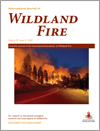International Journal of Wildland Fire
Volume 29
Number 9 2020
The probabilities of forest fires in Mexico are estimated using information on precipitation and temperature, along with data on type of vegetation, human activities near forests and fire prevention policies. The proposed model addresses the factors that account for extreme wildfire hazard, and may provide a basis for fire prevention actions, reducing vulnerability factors.
Given a set of suitable weather conditions within which prescribed burning may occur, we use projections from Global Climate Models to explore the potential effects of climate change on prescribed fire management in the south-eastern US. Results indicate substantial reductions in the number of available burning days during late spring and summer months, which would restrict burn window opportunities to cool-season months in many parts of the region.
We present an analysis of a regional climate model widely used in simulating fire weather for the south-west of Western Australia, one of the most bushfire-prone regions of Australia. We show that the model is able to simulate fire weather reasonably well and we analyse the source of errors.
Credible estimates of biomass are essential to predict pollution emissions from wildland fire, but direct measurements of biomass are rarely available before burning. We evaluated how variability in biomass estimates for a given vegetation type propagates to uncertainty in prediction of pollution emissions. We also identify the components of the wildland fuelbed that are most sensitive for predicting emissions.
Mastication in fire-prone ecosystems is used to alter vegetation structure and resulting fire behaviour when burnt in prescribed or wildland fire. Treatments convert live vegetation into downed material on the forest floor surface. Downed masticated fuels decomposed at an average rate of 6% per year in these novel fuelbeds.
Smouldering within forest fuels can be difficult to detect and persist long after the flames have been suppressed. This work seeks to determine the effects of fuel characteristics (e.g. moisture content) on how smouldering spreads within forest fuels. The results suggest that inorganic content and inorganic loading play a critical role in slowing spread rate.
We used analysis of phytoliths, plant silica particles that persist in soil for at least several hundred years after a plant dies, to estimate long-term vegetation and infer fire regime. These data-based estimates provide crucial information for managers trying to achieve fire mitigation and conservation goals.
The local and regional forest fire history of the Changbai Mountains for 13 000 years was investigated using charcoal records from a peatland in north-east China. Regional fires were promoted by a cold and dry climate and vegetation changes due to a weakened East Asian Summer Monsoon. Some fire prevention policies are proposed.





